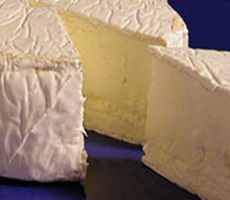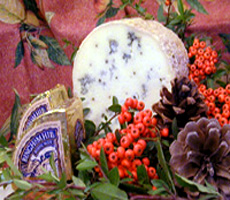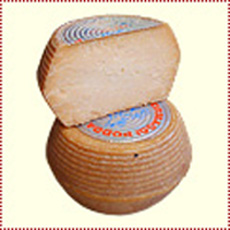

Addition of some cow’s milk to this largely sheep’s milk camembert from Old Chatham Sheepherding Company was found to improve the creaminess, velvety texture and buttery taste.
|
STEPHANIE ZONIS focuses on good foods and the people who produce them. Click here to contact her.
|
|
September 2005
|
 |
Whey To Go! ~ September 2005
-
Blended Milk Cheeses
-
Podda Classico
- Click here to for this month’s recommended cheese
- Click here for other months’ columns
Blended Milk Cheeses: The “Mixed Marriages” of the Cheese World
My name is Stephanie Zonis, and welcome to Whey to Go! Every month, we delve into a new cheese-related subject, and I offer a recommendation of a cheese I love. This month it’s blended milk cheeses.
That cheese is made from milk—cow’s, sheep’s, and goat’s milk cheeses are most familiar to American cheese lovers—is not news. But it might be news that some cheeses are made from blended milks of these animals. Blended milk (also called “mixed milk”) cheeses can be made from any combination of these three, and there are cheeses that incorporate milks from all three animals. (For purposes of brevity, the “Big Three” milk providers in other parts of the world—yak, water buffalo, and camel—will not be discussed here).
Cheese is an ancient food, and it is hard to believe that blended milk cheeses haven’t been around for almost as long. Initially, these mixed milk cheeses were likely the result of an accident or simple economy measures. Perhaps someone sought to save a little time by milking their goats and sheep into the same bucket. Or maybe, in that society of long ago, food was too precious to waste. Milk would have been an important source of calories and nutrition, but animals almost certainly produced less milk then, and combining milks may have ensured enough of a supply to make a reasonable quantity of cheese. In any case, cheese was a way to preserve this valuable food long after it otherwise would have spoiled. Fortunately for our ancestors, blended milk cheeses can be truly delicious.
With modern-day dairy science at our beck and call, we now understand more about how and why these cheeses can work so well. In the end, the mix of milks is based as much on economic decisions as it is on a knowledge of the cheesemaking process or an understanding of flavor. For example, cows’ milk is often the base for mixed milk cheeses wherever there is a large bovine population. A cow produces far more milk per animal than a sheep or a goat, so cows’ milk will be less expensive. It generally contributes a mild flavor and an acidity level good for cheesemaking. Ewes’ milk is higher in solids than either goats’ or cows’ milk, and a milk higher in solids will give a greater cheese yield. Because it is also higher in fat, sheep’s milk is known for contributing a rich flavor and a butteriness to cheese. By contrast, the milk of goats lends a mild tartness to a cheese, in addition to a whiter color (cows’ milk has a yellow cast to it).
Mixed milk cheeses can also be produced as a matter of seasonal economics. Bob Works, of Peaked Mountain Farm in Vermont, notes that he and wife Ann started making cheese with just thirty sheep. The six-month or so lactation cycle of a ewe begins with abundance but ends in scarcity, although the milk toward the end of the cycle is denser and richer. Toward the end of the lactation season, the Works were expending a lot of effort but ending up with very few finished cheeses. They were given mixed milk cheeses to try by a local promoter and enjoyed them, then wondered if they couldn’t try their hand at such products. Today, they make a sheep-cow cheese called Ewe-Jersey and a sheep-goat cheese, the latter made in smaller quantities and sold mostly at a local Farmers’ Market. Bob thinks he and Ann may have been the first people in Vermont to make these cheeses, and notes, “It was a way for us to stay in the business for a bit longer in the season.”
Laini Fondiller, of Lazy Lady Farm in Vermont, agrees. The milk yield from her goats decreases later in the season, but demand for her cheeses does not. Making cheese from both goats’ and cows’ milk helps her satisfy cheese lovers who buy her products; it’s also useful for her neighbor with an organic cow dairy, from whom she buys her cows’ milk! Laini makes two distinctly different mixed milk cheeses. Her Demitasse is made by blending cows’ and goats’ milk in the vat, while her Trillium consists of one layer each of cow and goat cheese, separated by a layer of ash. Laini notes that the cows’ milk in the Demitasse mellows the sharpness of the goats’ milk, while in the Trillium, the layer of cows’ milk cheese is yellow, providing a nice visual contrast to the white layer of goats’ milk cheese.
As may be deduced from Lazy Lady’s methods, cheesemaking is also an art. Bingham Hill Cheese Company of Fort Collins, Colorado, had been producing the cows’ milk Rustic Blue, in addition to their Sheepish Blue—made, of course, from ewes’ milk. However, the finished Rustic Blue cheeses were deemed too dry and crumbly. Blending in 20% sheep’s milk resulted in a creamier cheese that has a richer, earthier, more complex flavor. Interestingly, almost the reverse has been true for Old Chatham Sheepherding Company in New York State. |

Bingham Hill’s Rustic Blue won the 2002
Gold Medal for the Best American Cheese at
the Word Cheese Awards in London. |
When making their camemberts, they found that the addition of some cows’ milk improved the creaminess, velvety texture, and buttery taste of what had been a purely sheep’s milk cheese; in the peak, or fully ripened stage, the introduction of cows’ milk meant a less earthy taste, which was a desirable characteristic in this cheese. Old Chatham’s ricotta, also a mixed milk cheese, incorporates a 50:50 blend of wheys from both their Camemberts and their pure sheep’s milk cheeses. The Ricotta is kept at that blend ratio to ensure a consistent nutritional profile.
But surely Americans aren’t the only ones now making blended milk cheeses? Of course not! You may simply have been eating mixed milk cheeses for years without being aware of it. Several of the better-known Greek cheeses, such as manouri and kasseri, are blended milk varieties. In some instances, halloumi, made not only in Greece but in neighboring lands, is a mixed-milk cheese; it may be made solely with sheep’s milk or a combination of sheep’s and goats’ milks. A handful of Spanish cheeses, of which the best-known is iberico, are mixed-milk products and have had content standards set for them by that nation’s Ministry of Agriculture. Iberico, for instance, must contain a minimum of 50% cows’ milk, 30% goats’ milk, and 10% sheep’s milk. Mesta, also Spanish in origin, must have a minimum of 75% sheep’s milk and a minimum of 15% cows’ milk, but the cheesemaker has the option of up to a 5% goats’ milk content. In nearby Portugal, bica de queijo is made from the milk of goats, sheep, and cows, while amarelo da beira baixa uses sheep’s and goats’ milk. Additionally, there are a few French and Italian blended milk standbys, such as chaumes, robiola bosina, la tur, and cravanzina.
Although blended milk cheeses may have had accidental beginnings, their continued existence these days is assuredly deliberate. Try one or two for yourself, and see how successful these “mixed marriages” can be!
Cheese of the Month: Podda Classico
It’s got a vaguely Parmesan-like texture, but it’s crumblier. The color is roughly that of good Parmesan in the center of each wheel, but darkens toward the outside. The flavor is rich and very full, a bit earthy, a little sharp, and a trifle salty, though not overpowering. It is podda classico, September’s Cheese of the Month. This cheese, a mix of sheep’s and cows’ milks, is produced on the island of Sardegna (what Americans refer to as “Sardinia”). It’s aged from 6 to 11 months, and the unusual ridges on the exterior are the result of a curd-compacting technique during the cheesemaking process.
|
 |
Podda classico, a mix of sheep’s and cow’s milk
cheeses from Sardinia. |
Podda classico may be grated, but it can also be served sliced or in chunks. Ideal accompaniments? Any of the big, luscious, fruity red wines, such as those from California, Chile, Argentina, or Australia. This cheese also pairs nicely with sweet, juicy apples and pears; figs or fig jam; honey; and pear mostarda. Given its usual year-round availability, podda classico is a great choice any time. You can find it at Murray’s Cheese and other specialty cheese retailers.
Lifestyle Direct, Inc. All rights reserved. Specific sections of content are the copyright of their respective owners. Images are the copyright of their respective owners. 
|






